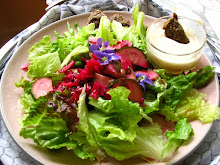| L | Dear Val, It can be hard to tell these days, especially when we visit the grocery store, that we are actually in the middle of winter. The produce section may be full of hothouse-grown veggies and out-of-season foods from all over the world. But just because they are available doesn't necessarily mean out-of-season foods are all that good for you. Foods grown in the spring and summer tend to grow faster and are more cooling in their nature. Foods grown in the fall and winter usually take a longer time to grow and are more warming. Even though we can now enjoy a fresh green salad or a hearty lamb and potato stew at any time of year, I bet you'll agree, Val, that a green leafy salad reminds us of the freshness of spring and a steaming bowl of stew makes us think of cold weather. Foods that are grown in season have higher levels of nutrients, and scientific studies support this. One Japanese study showed that spinach grown in the summer had three times more vitamin C than spinach grown in the winter. So, when you buy foods that are grown out of season, they may taste the same, but that doesn't mean they are nutritionally the same. It is a good idea to consider where you live, as the seasons and the local produce will vary between a colder climate, a warmer climate or more temperate one. Another excellent advantage of eating seasonally grown foods is that it is easier to find them at our local grocers, vegetable and fruit stands, and farmers' markets. Val, foods that are fresh and locally grown are filled with vital nutrients that will help boost your immune system. Plus foods in season are much less expensive, so your pocketbook benefits too. And taste wise, nothing beats fresh, locally grown fruits and vegetables harvested in the height of their season. So, in the spring and summer look for fresh greens like various lettuces; fresh corn and green beans; summer fruits like peaches, pears, apricots and all kinds of berries. In the fall and winter, look for leafy green vegetables like kale and collards; cruciferous veggies like broccoli and cauliflower; root vegetables like potatoes, carrots, sweet potatoes and fruits like apples. Val, by choosing to eat local foods that are in season, you'll be taking in the best and freshest nutrients for your body, which will improve your health and also allow you to enjoy the seasons even more. This is all about mindfulness. Being mindful and conscious of our environment, the people around us and ourselves. That is the best way to establish harmony in your life. I hope you will take some time to look over your forecast to see what the week holds. from Bethea@myhealthwealthandhappiness.com Look for me on Facebook and send a friend request if you would like to up-dated on delivery of organic produce in the St. Joseph, KC,Lawrence and Topeka areas. Don't do face-space, my-book? You can send me an e-mail at studiolevel@stjoelive.com I'll send you an e-mail version with lovely pictures and everything! Hugs -Val
|
Sunday, February 20, 2011
To Grocery Shop or Not to Grocery Shop, That is the Question
Wednesday, February 2, 2011
Vegetarian Garbonzo Bean Chili
Vegetarian Garbonzo Bean Chili
How to sprout garbonzos:
Cover dried beans with clean source water, no salt. Leave at room temperature overnight. Drain and add fresh water in the morning. Repeat until plump with a small white "tails". This may take 2 or 3 days. You may refrigerate to slow down the process or put near a heat vent, fireplace or radiator to speed up the process. When sprouted, wash with cool salt water and then cool clean water, drain. Add to a large pot with an ample amount of clean-source water with aromatics such as bay leaves, thyme bundles, garlic cloves, onion skins or herb stems. Do not salt again until beans are fully cooked. (About 40 minutes) Note: sprouted beans take less time to cook than dried beans. Reserve cooking liquid. The gelatinous "broth" made by garbonzo beans is one of the secrets to great hummus and chili! Refrigerate until ready to use.
Tip: Adding a piece of living sea weed to the soaking water makes for faster more nutritious sprouts. One 4" piece per gallon of water. Discard or add it to a house plant for food before cooking. you might even offer it as a treat to a house pet. some animals LOVE sea veggies. We love them too. But, we eat them dried in the dehydrator BEFORE they have been feeding the beans. (Mineral-rich Super-food!) Be sure to use ONLY hand-harvested, aboriginal, seasonally-collected, organic sea veggies. Our all-time fav is Mendocino Sea Palm Fronds. We did A LOT of research on this. We buy ours from Barbara and John Stephens-Lewallen atwww.seaweed.net. Let them know we sent you! They love St. Joe! Our sea vegetable purchases are growing in frequency and we are assisting them in their fight against corporate encroachment of ancient harvesting waters! Be healthy and be an activist, at the same time: buy hand-harvested sea weed.
How to make home-made chili sauce
1 gal bag of frozen tomatoes from the fall harvest (or 4 one-quart cans)
2 to 3 large onions, diced
5 to 10 garlic gloves, crushed
3 to 5 sun-dried tomatoes, packed in oil (diced)
6 to 10 drops of wild oregano oil (optional)
5 to 7 small dried whole chillies, 1 tsp each: whole cumin seeds, whole mixed gourmet smokey pepper corns, coriander seeds and dried oregano (if not using the oil)
1/2 tsp course ground Himalayan pink salt or living sea salt
Smokey paprika to taste
Add onions, tomatoes, garlic and sun-dried tomatoes to a crock pot or dutch oven. Cook on high to reduce liquid. while reducing, add dried whole spices and salt to spice mill or grinder and grind until fine. Add spice mixture to sauce, turn to low and simmer to desired consistency. Adjust seasoning, adding smokey paprika to taste and more salt and cumin as needed. Add meats, beans and other vegetables as desired to make chili or pot roast. Garbonzo beans can be added for thickening agent, but be careful not to overcook the garbonzos. They only need to be hated through in the warm chili sauce.
Gourmet Smokey Pepper Corns, Garbonzo Beans and Smokey Paprika are available for a limited time from Goode Acres Delivery. All other seasoning are available in the bulk section at A-Z Fresh Air Fare on 8th Street, down town Saint Joe.






